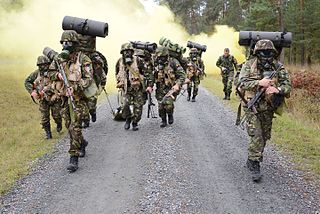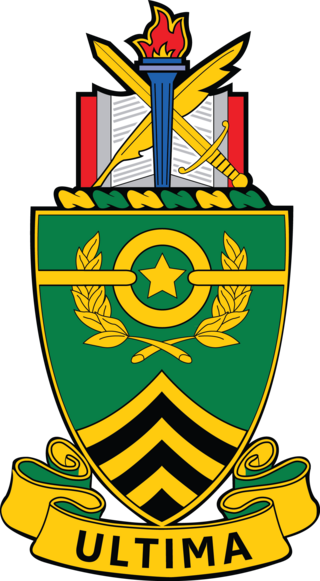A company is a military unit, typically consisting of 100–250 soldiers and usually commanded by a major or a captain. Most companies are made up of three to seven platoons, although the exact number may vary by country, unit type, and structure.
Military ranks are a system of hierarchical relationships within armed forces, police, intelligence agencies and other institutions organized along military lines. Responsibility for personnel, equipment and missions grow with each advancement. The military rank system defines dominance, authority and responsibility within a military hierarchy. It incorporates the principles of exercising power and authority into the military chain of command—the succession of commanders superior to subordinates through which command is exercised. The military chain of command is an important component for organized collective action.

In military terminology, a squad is among the smallest of military organizations and is led by a non-commissioned officer. NATO and U.S. doctrine define a squad as an organization "larger than a team, but smaller than a section." while U.S. Army doctrine further defines a squad as a "small military unit typically containing two or more fire teams." In American usage, a squad consists of eight to fourteen soldiers, and may be further subdivided into fireteams.

A non-commissioned officer (NCO) is a military officer who does not hold a commission. Non-commissioned officers usually earn their position of authority by promotion through the enlisted ranks. In contrast, commissioned officers usually enter directly from a military academy, officer training corps (OTC) or reserve officer training corps (ROTC), or officer candidate school (OCS) or officer training school (OTS), after receiving a post-secondary degree.
Corporal is a military rank in use by the armed forces of many countries. It is also a police rank in some police services. The rank is usually the lowest ranking non-commissioned officer. In some militaries, the rank of corporal nominally corresponds to commanding a section or squad of soldiers.
A master sergeant is the military rank for a senior non-commissioned officer in the armed forces of some countries.

The commanding officer (CO) or commander, or sometimes, if the incumbent is a general officer, commanding general (CG), is the officer in command of a military unit. The commanding officer has ultimate authority over the unit, and is usually given wide latitude to run the unit as they see fit, within the bounds of military law. In this respect, commanding officers have significant responsibilities, duties, and powers.

The mess is a designated area where military personnel socialize, eat and live. The term is also used to indicate the groups of military personnel who belong to separate messes, such as the officers' mess, the chief petty officer mess, and the enlisted mess. In some civilian societies this military usage has been extended to the eating arrangements of other disciplined services such as fire fighting and police forces.
A Noncommissioned Officer Professional Development Ribbon is an award presented by the United States Army, Air Force, and Space Force to recognize those noncommissioned officers (NCOs) who have completed a prescribed leadership course at an NCO training school. The Navy, Marine Corps, and Coast Guard have no equivalent to the Noncommissioned Officer Development Ribbon.
A NATO standard grade scale is used by the NATO and its partners for the purpose of comparing military ranks across the member nations militaries, as well as for a number of administrative tasks.

Eric W. Benken is a retired airman of the United States Air Force who served as the 12th Chief Master Sergeant of the Air Force from 1996 to 1999. He was the last Vietnam War veteran to hold the position.

The United States Army Sergeants Major Academy (USASMA) was established on 1 July 1972 at Fort Bliss, Texas, and began instruction in January 1973. Its curriculum is designed to broaden the student's current knowledge base. This approach differs from the Military Occupational Specialty (MOS) related training at the basic and advanced levels of the Noncommissioned Officer Education System. The prime educational technique employed throughout the course is the small group participatory learning process.

United States Marine Corps rank insignia are the devices worn by officers in the United States Marine Corps, in order to provide distinction from other ranks. Different styles of rank insignia are worn on different uniforms of the United States Marine Corps.

The California Cadet Corps (CACC), originally called the California High School Cadets, is a component of the California Youth and Community Programs Task, Task Force Torch. The California Cadet Corps is a paramilitary youth organization in California open to students in the college, high school, middle school and elementary school grades.
In many militaries, a platoon sergeant is the senior enlisted member of a platoon, who advises and supports the platoon's commanding officer in leading the unit.
The U.S. Army Creed of the Noncommissioned Officer, otherwise known as the Noncommissioned Officer's Creed, and commonly shortened to the NCO creed, is a tool used in the United States Army to educate and remind enlisted leaders of their responsibilities and authority, and serves as a code of conduct. Each branch has their own version, and many have been altered over the years.

All branches of the United States Armed Forces use the general term Enlisted Professional Military Education (EPME) to describe the formal system of education which each branch provides to its enlisted personnel. Each branch has its own system and sequence of courses, with the overall focus on leadership and management. Education generally increases in intensity and level of knowledge as individuals progress in rank and assume broader leadership roles. EPME is distinct from the technical training which service members receive for their Military Occupational Specialty (MOS), Air Force Specialty Code (AFSC), or Navy Rating.

The I.G. Brown Training and Education Center is a detachment of the Air National Guard Readiness Center and is located at McGhee Tyson Air National Guard Base near Knoxville, Tennessee. The TEC conducts an average of 16 Enlisted Professional Military Education courses and 40 Professional Continuing Education sessions throughout the year. Typically, the TEC accommodates 11,000 service members on campus annually from the Total Force, United States Coast Guard, and partner nation armed forces. TEC also manages the ANG's Warrior Network; a $7 m satellite broadcast enterprise with more than 186 downlink sites, providing training, education and command information nationwide. In addition, the studio and multimedia facilities support ANG video productions, senior leader conferences and general-to-career field-specific training.

The United States Army's Noncommissioned Officer Candidate Course (NCOCC), originally located at Fort Benning, Georgia, was created to fill the Army's critical shortage of junior noncommissioned officers with the best qualified and best trained men available. NCO Candidates (NCOC) allowed to attend the course were selected from volunteers and many candidates were among the brightest soldiers of Basic Combat Training, Advanced Individual Training or in a subsequent assignment that demonstrated outstanding leadership potential. The program was in existence only during the U.S. war in Vietnam.
The military ranks and insignia of Chile are the military insignia used by the Chilean Armed Forces.










